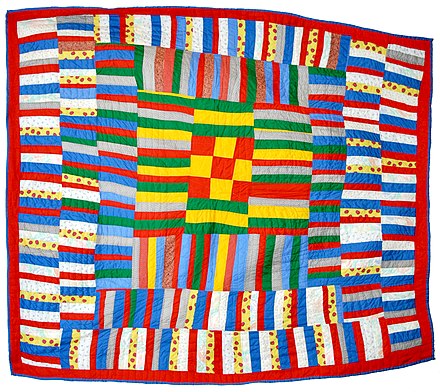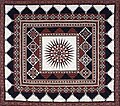Louisiana Bendolph is an American visual artist and quilt maker. Bendolph is associated with The Quilts of Gee's Bend and her work has been considered more conceptual because of her use of vibrant color.
Mary Lee Bendolph is an American quilt maker of the Gee's Bend Collective from Gee's Bend (Boykin), Alabama. Her work has been influential on subsequent quilters and artists and her quilts have been exhibited in museums and galleries around the country. Mary Lee uses fabric from used clothing for quilting in appreciation of the "love and spirit" with old cloth. Mary has spent her life in Gee's Bend and has had work featured in the Philadelphia Museum of Art as well as the Minneapolis Institute of Art in Minnesota.
Lucy Marie (Young) Mingo is an American quilt maker and member of the Gee's Bend Collective from Gee's Bend (Boykin), Alabama. She was an early member of the Freedom Quilting Bee, which was an alternative economic organization created in 1966 to raise the socio-economic status of African-American communities in Alabama. She was also among the group of citizens who accompanied Martin Luther King Jr. on his 1965 march from Selma to Montgomery, Alabama.
Loretta Pettway Bennett is an American artist. She is associated with the Freedom Quilting Bee, where her mother, Qunnie Pettway, worked, and with the Gee's Bend quilt-makers. Her quilts Sew Low and Vegetation are part of the Eskenazi Health Art Collection.
Aolar Carson Mosely was an American artist. She was a founding member of the Freedom Quilting Bee, and is associated with the Gee's Bend quiltmakers, along with her daughter Mary Lee Bendolph and her granddaughter Essie Bendolph Pettway. Almost all of her quilts were destroyed when her house burned down in 1984.
Nettie Jane Kennedy (1916–2002) was an American artist associated with the Gee's Bend group of quilters.
Martha Jane Pettway (1898-2003) was an American artist associated with the Gee's Bend group of quilters. Pettway was born in Gee's Bend, Alabama and lived her entire life there. Her work is included in the collection of the Philadelphia Museum of Art.
Jessie T. Pettway is an American artist associated with the Gee's Bend group of quilters.
Delia Bennet was an American artist. She is associated with the Gee's Bend quilting collective, and is said to be "the matriarch of perhaps the largest family of quilt producers in Gee's Bend." Her work is included in the collection of the Philadelphia Museum of Art.
Annie E. Pettway (1904–1972) was an American artist. She is associated with the Gee's Bend quilting collective. Her work has been exhibited at the Museum of Fine Arts, Houston and is included in the collection of the Philadelphia Museum of Art.
Andrea Pettway Williams is an American artist. She is associated with the Gee's Bend quilting collective, along with her mother, Lorraine Pettway. Her work has been exhibited at the Museum of Fine Arts, Houston, and is included in the collection of the Philadelphia Museum of Art. She is a sixth-generation quilter.
Nettie Pettway Young was an American artist. She is associated with the Gee's Bend quilting collective and was an assistant manager of the Freedom Quilting Bee. Her work has been exhibited at the Museum of Fine Arts, Houston and the Frist Art Museum, and is included in the collections of the Philadelphia Museum of Art and the Nasher Museum of Art.
Arcola Pettway (1934-1994) was an American artist associated with the Gee's Bend group of quilters.
Lutisha Pettway (1925–2001) was an American artist associated with the Gee's Bend group of quilters.
Bettie Bendolph Seltzer was an American artist. She is associated with the Gee's Bend quilting collective, along with her mother, Annie Bendolph, and her mother-in-law, Sue Willie Seltzer. She worked at the Freedom Quilting Bee.
Lucy T. Pettway (1921–2004) was an American artist. She is associated with the Gee's Bend quilting collective. Her work has been exhibited at the Museum of Fine Arts, Houston and the Frist Art Museum, and is included in the collection of the Metropolitan Museum of Art.
Rachel Carey George (1908–2011) was an American artist. She is associated with the Gee's Bend quilting collective, alongside her aunt Delia Bennett. Her work is included in the collection of the Museum of Fine Arts, Houston.
Annie Bell Pettway (1930–2003) was an American artist. She is associated with the Gee's Bend quilting collective, along with her daughter Belinda Pettway.













